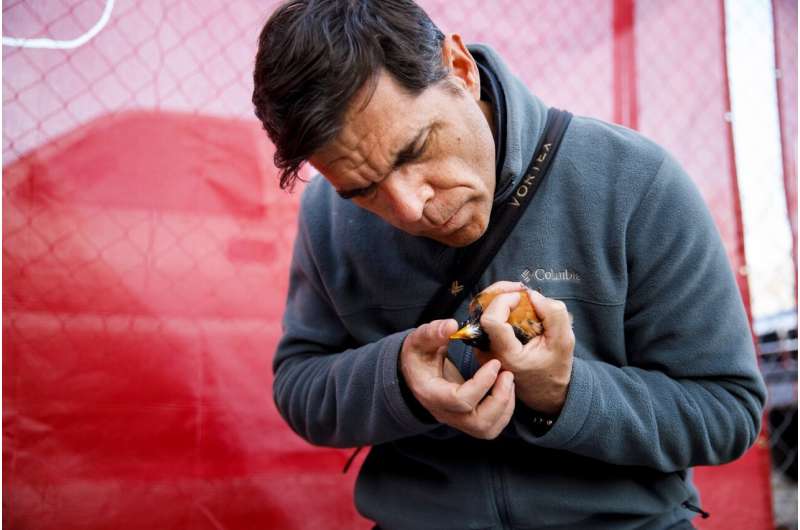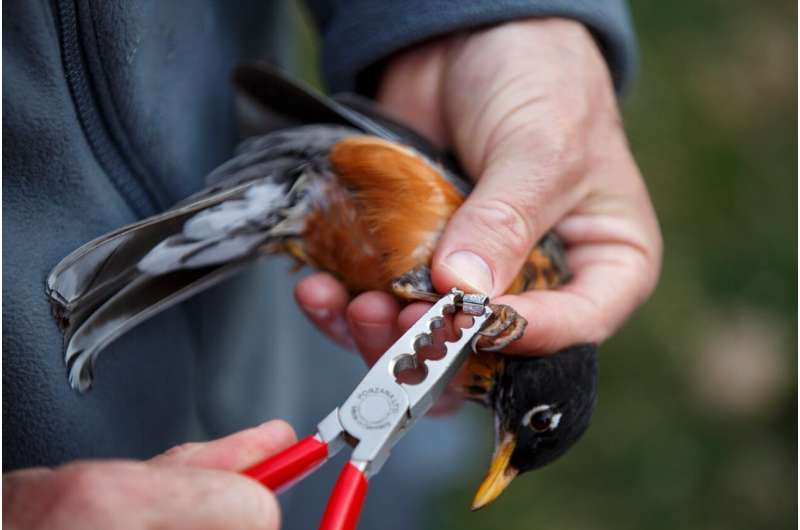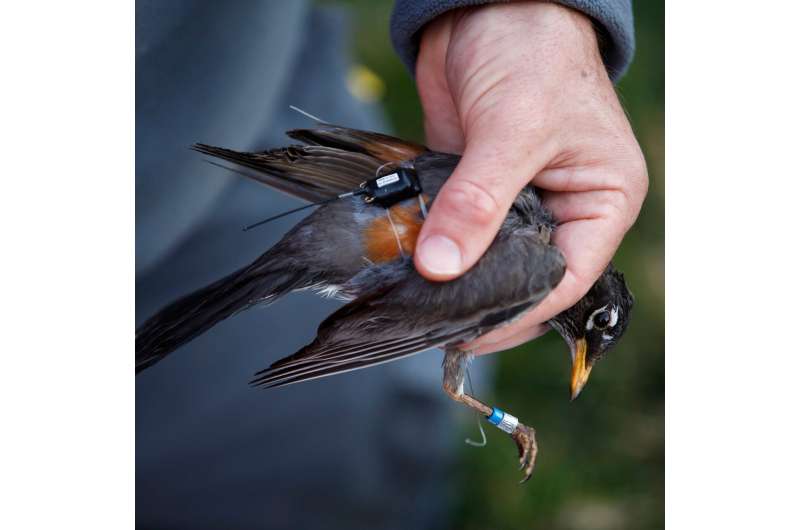Birds outfitted with 'backpacks' to research environmental change

As a child visiting his grandmother's farm in Illinois, Alex Jahn used to gaze up into the evening sky and watch Canada geese on their long flight home for summer.
Now a fellow with the Environmental Resilience Institute at IU, a part of the IU Prepared for Environmental Change Grand Challenge initiative, Jahn is an expert on bird migration who studies how changes in bird behavior can shed light on environmental change.
"The idea that these geese had migrated all the way down to Texas and Louisiana and then headed back up north to Canada, it just blew my mind as a kid," said Jahn, who joined IU in 2018. "Maybe it's that birds are so small and yet accomplish these great marathons—a great odyssey that most people don't even realize is happening right over their heads. Everyone who dedicates their life to science probably has a similar memory. It's the fascination that keeps you going."
Before joining IU, Jahn spent about a decade working in both South America and the U.S., studying migratory behavior in thrushes and a few other species. This included two years under a grant from the National Science Foundation to track scissor-tailed flycatchers and western kingbirds in Oklahoma, as well as four years as a visiting professor and researcher at São Paulo State University in Brazil. He also spent two years at the Smithsonian's Migratory Bird Center in Washington, D.C., conducting field work in Brazil on three species of thrush that never travel outside the tropics.
"One question in bird migration research is: Why do some birds travel all the way to the tropics every year to spend the winter, while others don't?" Jahn said. "We want to know more about different migratory strategies—the distance, the speed—as well as which birds are at greater risk from climate change based upon their particular behaviors."
Jahn's tools of the trade include GPS trackers—or "tiny bird backpacks"—weighting only 2 grams, which can follow a bird's movement anywhere in the world for a year; as well as miniscule, colored leg bands that identify individual birds upon their return to their capture location the following year.
At IU, Jahn is focused on tracking the American robin, a species of thrush that is surprisingly understudied despite being widespread across North America. (Always on the lookout for robin nests on campus, Jahn is rarely out of the office without binoculars. His favorite spot is the marshlands off the Jordan River near the Wendell Wright Education Building.) In addition to using the trackers and bands, Jahn also collects a small blood sample from each bird to test for diseases such as Lyme and avian malaria.
American robins can migrate as far north as northern Canada and as far south as Mexico. As warmer weather draw near in Indiana, Jahn also plans to do summer work on robins in Alaska. He also plans a trip to South America in October to continue research on tropical thrushes.

"Everything I'm doing here in Indiana with robins, I'm also doing in Brazil and Argentina with other species," Jahn said. "But this project isn't about saving the robins. Instead, we're interested in them as sentinels of ecosystem change. They're our 'canary in the coal mine.'"
Unlike mammals who can hibernate in lean times, he added, birds need food on a nearly hour-to-hour basis, which means they're powerful barometers of ecosystem health. Changes in their behavior give an early signal about other shifts down the food chain.
"Birds are affected by the same environmental processes, such as rainfall, that drive the timing of flowering and fruiting, of crops and insects," he said.
Some of the work connecting these dots occurs in collaboration with other colleagues who track bird and animal species through the Movement Ecology Group of the Environmental Resilience Institute at IU. For example, the birds' blood samples will inform the institute's tick monitoring project, which seeks to understand how bug-borne diseases are spreading in the state.

Jahn is also working with another of the institute's fellows, Tara Smiley, to study bird ecology using isotopic analysis. The same method used to detect drugs in human hair can reveal details about birds' movements and diet from a single feather.
Moreover, Jahn said his recruitment under IU's Grand Challenges Program connects him with collaborators beyond biology, including plans to work with students from the O'Neill School of Public and Environmental Affairs at IU Bloomington, as well as biology graduate students.
"This is a real pioneering project in many ways," he said. "While other universities have grand challenges, they aren't commonly focused on environmental change—or they aren't on the same scale as IU's. We're approaching this topic from so many angles—not only in terms of biology, but also policy, conservation law, history, art and communications.
"If there's anything we've learned over the past few years, you simply can't tackle an issue as large as a grand challenge without being truly interdisciplinary."
Provided by Indiana University



















